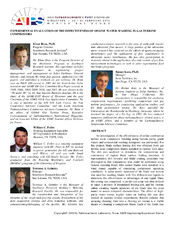| dc.contributor | Asia Turbomachinery & Pump Symposium (1st : 2016) | |
| dc.creator | Brun, Klaus | |
| dc.creator | Grimley, Terrence | |
| dc.creator | Foils, William | |
| dc.creator | Kurz, Rainer | |
| dc.date.accessioned | 2017-05-04T12:49:12Z | |
| dc.date.available | 2017-05-04T12:49:12Z | |
| dc.date.issued | 2016 | |
| dc.identifier.uri | https://hdl.handle.net/1969.1/160266 | |
| dc.description | Lecture | en |
| dc.description.abstract | Lecture 7: An investigation of the effectiveness of online combustion turbine axial compressor washing using various purity grade waters and commercial washing detergents was performed. For this project, blade surface fouling dirt was obtained from gas turbine axial compressor blades installed at various field sites. The dirt was analyzed to determine the composition and consistency of typical blade surface fouling materials. A representative dirt formula and blade coating procedure was developed so that comparative tests could be performed using various cleaning fluids. Dirt coated blades were installed in a wind tunnel capable of simulating compressor operating conditions. A spray nozzle upstream of the blade test section was used for washing blades with five different test liquids to determine the effectiveness or advantages of any liquid. Once this testing was completed, a similar test setup was then utilized to inject a mixture of formulated fouling dirt, and the various online cleaning liquids upstream of the blade into the wind tunnel to assess redeposit characteristics. The effect of high-purity water versus regular water on fouling dirt was also studied in separate residue experiments. Results indicate that spraying cleaning fluid into a flowing air stream is a viable means of cleaning a compressor blade. Each of the fluids was able to clean the test blade at both low and high air velocities and at different blade incident angles. Within the parameters/fluids tested, the results indicate that: 1. The blade cleaning is primarily a mechanical function and does not depend on the type of fluid used for cleaning. The results showed that most of the cleaning occurs shortly after the cleaning fluid is introduced into the flow stream. 2. Dirt removed from the blades may redeposit in other areas as the cleaning fluid is evaporated. Redeposit occurred in flow recirculation zones during the cleaning tests, and heated flow tests demonstrated dirt deposit in the presence of a cleaning fluid. In addition, the type of fluid used for cleaning has no effect on the redeposit characteristics of the dirt. 3. Blade erosion was not found to be a significant issue for the short durations that online water-washing was performed. However, uncontrolled water-washing (or overspray) for extended periods of time did result in measureable leading and trailing edge blade erosions | en |
| dc.format.medium | Electronic | en |
| dc.format.mimetype | application/pdf | |
| dc.language | en | |
| dc.publisher | Turbomachinery Laboratories, Texas A&M Engineering Experiment Station | |
| dc.relation.ispartof | Asia Turbomachinery & Pump Symposium. 2016 Proceedings. | en |
| dc.subject.lcsh | Turbomachines | en |
| dc.subject.lcsh | Pumping machinery | en |
| dc.title | Experimental Evaluation of the Effectiveness of Online Water-Washing in Gas Turbine Compressors | en |
| dc.type.material | Text | en |
| dc.identifier.doi | https://doi.org/10.21423/R15H68 | |


